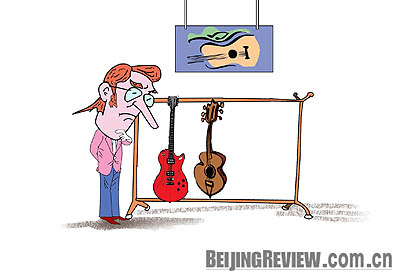|

I remember the first guitar I bought, handed down from a dusty shelf at the Xidan Department Store in Beijing. The shop assistant, in striped blue-white shirt, knew as little as I did about the strings. It was a Starsun, a name suggesting nature and dreams, like those names suggesting harmony and nature stamped in gold letters on yellow pencils from China, which I carried to school in the 1980s. The guitar's wood smelt like those pencils too.
I had a guitar, and it was nice to look at, a rich cobalt blue. The portly and cheerful woman who sold it called on a colleague in the next floor who had played some erhu, the sorrowful-sounding Chinese instrument. Though accustomed to the erhu's two strings, she somehow managed to whack the Starsun's six strings into some kind of tune.
The strings were too far off the frets and the instrument's neck was far too wide for comfort. I have bought five guitars, one for each year I've spent in China, and have given most of them away as presents to friends who have also since taken up the instrument.
The image of cheap entry-level guitars is proving hard to shift for China, which has fast become the workshop of the world's guitar makers. Many guitar makers here have drifted into the business-unlike Western brands such as Gibson that developed guitars for and by particular accomplished musicians such as 1960s blues star Les Paul. Companies doing guitars here lack the tradition of Gibson and struggle to make anything better than cheap entry-level instruments for big-box retail clients like Wal-Mart. Like my cobalt blue acoustic, they may look good but sometimes sound awful.
China may be the world's top maker of guitars and pianos but it hasn't managed to come up with any decent brands of its own. Korean companies (subcontracting for Japanese clients like Yamaha) tend to dominate China's local manufacturing scene. One of the largest, Korea-owned Sejung in east China's Qingdao, Shandong Province, makes a Yamaha acoustic for $50 (compared to the $300 it would cost at a Japanese workshop).
In China, there are none of the old-school musical instrument emporiums you find in towns like Manchester in the UK, or New York, where knowledgeable staff, usually musicians themselves, pluck and tune strings for some of the world's successful contemporary musicians.
Staff at Beijing's big state-owned department stores still sell guitars like they do shoes or sacks of noodles, simply another product made in China for less. But there's a new wave of smaller, more knowledgeable outlets, most of them on a street crammed with guitar shops on the city's Gulou Street, an historic district whose gray-stone streets brim with cafes, crafts and musical instruments. Rows of guitars hung from ceiling to floor squeeze the space in these narrow shop spaces fashioned out of traditional low-rise homes.
Up to recently, no one in Gulou could explain to me the differentials in price on guitars that otherwise look the same. A Yamaha FG7325 acoustic model costs 400 yuan ($57) while identical-looking Yamaha FG700S costs 4,000 yuan ($570) because they're made of different wood: One is made of a resin, the other spruce. The simple answer is, different woods make for very different sounds.
Probably because the domestic market for guitars remains in its nascent stages, local guitar technicians have much to learn. On a recent Sunday walk-around of Gulou's musical instrument shops, however, I met a man who knows his guitars: Wu Ligen, a technician at the maintenance department at GAid, a guitar maintenance store sandwiched between a clothes shop and a tea vendor.
Nine G-Aid employees brandish pliers, screwdrivers and bottles of wood varnish as they labor over foreign and locally made guitars. Two trainees cram around worktops to hear Wu's expert explanation of the circuit boards on a cherry-colored Gibson Les Paul model, cut open for the purposes of explanation.
Wu learned most of his trade from foreign guitar magazines he bought online. "Materials and sound quality are both better in foreign-made guitars than in Chinese guitars," professes Wu. "They're more exquisite…and the timbre is much better, you can tell that easily by listening to a Chinese and then a Western or Japanese guitar."
In half a decade in China I've learned to play passable guitar and China has been learning how to make guitars. Staff in local music shops are still learning, but I'm given hope by the likes of Wu. Hopefully China's guitars will become known as much for quality as for price. When that happens, the idea of buying and playing a guitar in this country of erhus will sound good to me. |